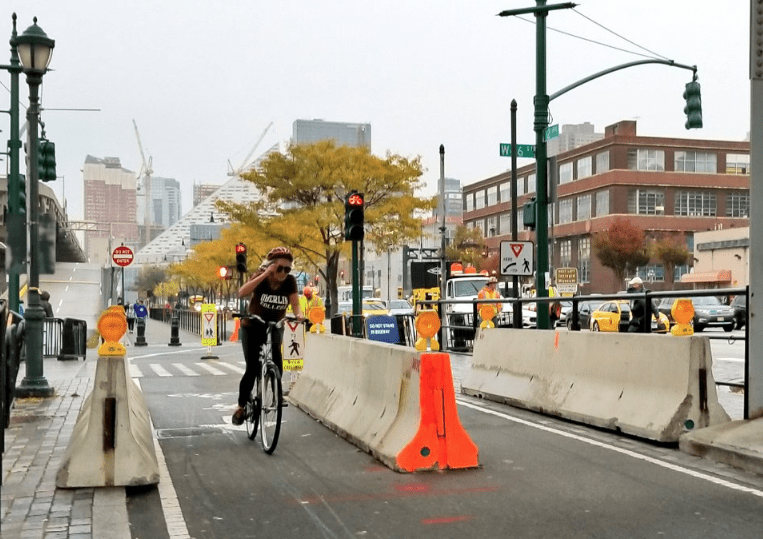Sometime in the next year or so the makeshift security barriers on the Hudson River Greenway will give way to permanent bollards to keep cars out. The question is whether the agencies in charge of the greenway will use best practices to improve safety, or botch the job and make the greenway unrideable for the large number of people who bike on it.
Last night, the Manhattan Community Board 2 transportation committee discussed the situation and unanimously passed a resolution asking New York State DOT to study "pedestrian, bicycle, and illegal motorized vehicle congestion" on the bikeway before the agency implements more permanent safety measures.
Already, the greenway is bursting at the seams during warmer months and needs to be widened to handle the peak volume of bike and pedestrian traffic it carries.
The Jersey barriers currently lining dozens of entry points to the greenway were placed by State DOT after last October’s fatal vehicular attack. The barriers create chutes 60 inches wide, requiring people on bikes to slow down and proceed single file. This has created several pinch points on the greenway in CB 2's turf, from Canal Street to 14th Street.
The state plans to replace the temporary barriers with permanent bollards spaced only 48 inches apart. That alarms greenway users like Nancy Brous, who bikes with her 10-year-old children. The pinch points on the greenway already make her so nervous that she often opts to ride with her kids on the streets instead.
She held up a tape measure at 48 inches to stress how narrow the clearance would be. “To prevent a future terrorist attack, they’re making the path dangerous for daily users,” she said.
CB 2’s resolution requests that “no permanent bollards be installed at 48 inch widths until this traffic study has been completed and is available for public review."
“I cycle everywhere in the city, I use the bike lanes, and 48 inches is certainly too little to allow cyclists to pass on the West Side bike lanes,” said West Village resident Daniel Katzen. “As someone who cycles almost 200 miles a week in the city, making it more accessible to cyclists is critical.”
Reed Rubey, a daily bike commuter, said the greenway is failing precisely when people need it the most. “I ride from Harlem to Tribeca on the greenway and it’s the highlight of my day both times. And my experience is that it’s great in the winter when nobody’s on it, but the minute the weather picks up, it’s a very dangerous thing to navigate. I’m very good with my bike, but the challenges I find on the greenway are more difficult than just about anywhere else in the city.”
The multitude of different conveyances on the greenway no longer fit comfortably within its current dimensions. Cyclists, runners, skateboarders, kids on scooters, and people on e-bikes travel at varying speeds.
The greenway isn't designed to handle all of them, and some people on the greenway feel intimidated by the faster e-bikes, said Graeme Birchall, president of the Downtown Boathouse on Pier 26 in Tribeca, which offers free public kayaking to 30,000 people every year.
“It’s driving some people off the bike path. I get complaints from people with children, I get complaints from seniors, I have a lot of volunteers who are female, who just will not ride on the bike path,” he said.
The board responded by including language in its resolution about the “lack of enforcement to mitigate dangerous riding behavior” and calling for rumble strips that create vibrations at higher speeds, setting a speed limit, installing signage to direct traffic movement in a safe and orderly manner, and addressing other ways to enforce safe speeds and courteous behavior on the greenway.






